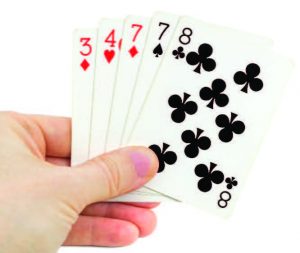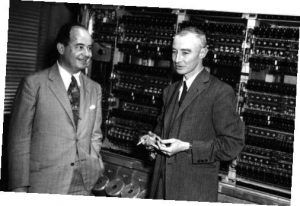John Nash, Ralph Kramden and Game Theory in New Jersey
By Luke Sacher
Sorry, Harvard and Yale. When it comes to Game Theory, you’re just safety schools. The Einsteins at Princeton basically wrote the book used by everyone from economists and multinational corporations to defense strategists and Survivor contestants. Which, for all practical purposes, makes New Jersey the birthplace of Game Theory. Most of us were introduced to the idea of Game Theory in the 2001 film A Beautiful Mind, starring Russell Crowe as Princeton professor John Nash. Some may remember the Matthew Broderick vehicle, War Games (“Shall we play a game?”), which introduced the concept to moviegoers as far back as 1983.

Courtesy of the World Economic Forum
Whether you realize it or not, if you happen to be the parent of a college-bound teenager, Game Theory is coming into play again, this time in a much more personal way. Both the application process and admissions process involve the fundamentals of high-stakes probability that were originally hammered out by three Princetonians: John Von Neumann, Oskar Morganstern and Nash (above)—right here in the Garden State. More on these three on page 78.
In a twist that this trio would no doubt appreciate, many colleges now invite young applicants to expound on Game Theory in their essay options. So let’s just say that it’s good to know what you’re getting into.
Game Theory is the application of mathematical probability and symbolic logic to the understanding of rational human behavior in interactive situations between two or more “players.” It takes how we expect individuals to behave, or to make decisions, and then adds the element of interaction with others who are also seeking to maximize their benefits by acting rationally. In other words, Game Theory is no game at all. Rather, it is a tool for analyzing situations where each player is exercising “strategic interdependence”—calculating actions and outcomes based on the decisions of others in the game.

www.istockphoto.com
THE ADVERTISER’S DILEMMA
In its most basic form, Game Theory helps to understand situations that are familiar to all of us. Take the “Advertiser’s Dilemma.” Two companies producing a similar product (let’s say Hershey and Nestlé and chocolate bars) are in competition with each other for customers. The maximum payoff for both companies happens if both do not advertise, since they are saving the expense of advertising. The minimum payoff for each company happens if it chooses not to advertise and the rival company does—thus cratering its market share. So both companies decide to advertise, dividing market share more or less evenly while squeezing out a small profit.

www.istockphoto.com
Even if Hershey and Nestlé were to hammer out a gentleman’s agreement not to advertise, the two companies would likely operate in a state of sustained paranoia that the other might betray them and advertise (which is no way to run a business). The lesson Game Theory teaches us in this case is that expending resources and not getting much in return is preferable to not expending resources and risking getting even less. It’s akin to the spiraling logic employed by Ralph Kramden when he launches into one of his “You know that I know that you know that I know…” soliloquies in a Honeymooners rerun.
The difference between Ralph Kramden and John Nash (who, ironically, were contemporaries) is that Nash was able to express this idea mathematically and arrive at an elegant, logical conclusion—for which he eventually won a Nobel Memorial Prize in Economics, in 1994. The Nash Equilibrium, his solution concept for non-cooperative competition, is now employed in one way or another in almost every aspect of global business.
 GAMING THE SYSTEM
GAMING THE SYSTEM
Although all roads leading to college run through Princeton (where SATs, ACTs, Achievement and Advanced Placement exams are scored by the College Entrance Examinations Board), only 6 percent of the 30,000 or so kids applying to New Jersey’s top school will get in. That leaves a lot of smart kids looking elsewhere, and this is where a firm grasp of Game Theory can be helpful.

www.istockphoto.com
If your kids can write with imagination and authority on the topic of Game Theory in a college essay, more power to them. Not only have they managed to stand out in a crowded field, they have made the job of the admissions officers reading that essay easier. Which increases their chances of landing on the acceptance pile. If that sounds
like an example of Game Theory within Game Theory, then you’re getting it! The fact is that—because of the sheer volume of applications they now receive—college admissions departments are applying Game Theory to their acceptance strategies.
Let’s say that a school has 10,000 qualified applicants for 1,000 openings in the incoming freshman class. How many should it accept, given that an unknown percentage will inevitably decide to attend another college to which they have also been accepted? If the college accepts 3,000 and half show up for orientation, the extra 500 kids will overwhelm the school. But what if, of those 3,000, only 10 percent decide to attend? With 300 incoming freshmen instead of 1,000, a financial crisis would almost certainly ensue.

www.istockphoto.com
In this game, one of the players is the college and the other is the student. Both are attempting to make decisions under conditions of uncertainty and incomplete or “hidden” information. It’s been described as a chess match, but it’s not. Poker is the game here. And in poker, you don’t always need the better hand to win—you can also win by maneuvering your opponent into a bad decision.
The college is trying to reduce uncertainty and achieve its goals by convincing the most qualified applicants to show up on their campus instead of someone else’s, even if that other school might represent a better choice. The win here for the school is filling the 1,000 spots with the most talented group of freshmen possible. The student, of course, is trying to wangle as many acceptance letters as he or she can, in order to go to the best possible college. The win for the teenager is gaining acceptance to that coveted “reach” school, ideally under the best financial circumstances. Keep in mind, for every kid that gets into a reach school, there is probably a more qualified student who is rejected, often because the admissions department “knows” the better student is headed elsewhere anyway. Which is why no reach school is ever a slam-dunk rejection.
One aspect of Game Theory that has come into play in a big way on the admissions side is the extensive wait listing of qualified applicants. This strategy gives schools more time to understand and evaluate the pool of prospective freshmen, and to create more certainty in achieving bottom-line goals. Of course, our kids are bright enough to know the correct response: Apply to 30 schools!
It’s a solution both Kramden and Nash, in their own utterly unique and ingenious ways, would probably appreciate.
OUTSTANDING
Who has the power in the college entrance process? The more skilled player. A recent article in the Wall Street Journal offered some thoughts on gaming the admissions system:
- Play the Oboe or the Harp, and play it well. The old ideal of the All-American athlete/Latin scholar/musical-comedy star is long gone. Schools today want to see a lot of talent in a specific field, though exactly what they’re looking for varies. Colleges are looking more for a well-rounded class than well-rounded freshmen.
- Spend a summer at the school of your choice. A growing number of schools, like Brandeis and Harvard, are trying to get to know potential applicants by offering summer programs. Some let high school kids take college courses and earn college credit.
- Move to Idaho. Seriously. Colleges and universities want geographic diversity.
- Get a life. A survey by the National Association for College Admission Counseling found that extra-curriculars now rank ninth in importance. Grades in college prep courses were #1. Colleges like to see students who take time to develop into more complete human beings, including those who take a gap year after high school to explore the world.
GAME ON
There are four core elements of all games:
1) Players (sometimes called agents)
2) Information available to each player, whether complete or incomplete, symmetric (common to all players) or asymmetric (unique to individual players)
3) Actions available to each player at each “move,” whether simultaneous or sequential, made by the players based on their information
4) Payoffs (positive or negative) available to each player for each outcome of their actions
A game theorist typically uses these elements, along with a solution concept of their choosing (such as the Nash Equilibrium), to deduce a set of equilibrium strategies for each player. These equilibrium strategies help determine a stable state in which either one outcome occurs or a set of outcomes occur with known probability. If these strategies have been correctly calculated, no player can profit by unilaterally deviating from his or her strategy. However, where Game Theory falls apart is when one or more players acts irrationally. In poker, it’s not the end of the world.
In thermonuclear warfare, it is.
NEW JERSEY’S “BIG THREE”

Courtesy of the Mises Institute
Oskar Morgenstern
(1902-1977)
Morgenstern grew up in Vienna, Austria and graduated from the University of Vienna in 1925. After earning his doctorate in political science, he succeeded Nobel laureate economist Friedrich Von Hayek as director Courtesy of the Mises Instituteof the Vienna Institute for Business Cycle Research, and held the position until the Nazi annexation of Austria in 1938. Fortunately, he was visiting Princeton University at that precise moment, where he met and befriended John Von Neumann. The two began a six-year collaboration at Princeton that would result in the publication of The Theory of Games and Economic Behaviorin 1944, which is universally recognized as the first book on Game Theory.
John Von Neumann
(1903-1957)
Von Neumann (below left, with physicist J. Robert Oppenheimer) was born on December 28, 1903, in Budapest, Hungary. By the age of 8, he was familiar with differential and integral calculus, and published his first paper at the age of 18. He earned his first degree at the University of Budapest in 1925, in Chemical Engineering,
books while operating his vehicle, occasioning numerous arrests, as well as accidents. Von Neumann was not only one of the fathers of Game Theory, he also worked on the mathematical formulation of quantum mechanics, made invaluable contributions to the Manhattan Project, and was involved in the development of the first programmable digital computers.
 John Forbes Nash, Jr.
John Forbes Nash, Jr.
(1928-2015)
Nash was born June 13, 1928 in Bluefield, West Virginia, where he demonstrated his exceptional talent for mathematics as early as age 10. He was accepted to Carnegie Tech on a full Westinghouse scholarship and graduated at age 19 with a Master’s Degree in Mathematics. Nash then won a graduate studies scholarship from Princeton University in 1948. From the early 1950s to the mid-1980s, Nash suffered tortuously from extreme bouts of psychosis, and was often hospitalized and institutionalized. Forty-four years after completing his revolutionary 27-page doctoral dissertation at Princeton, he shared the 1994 Nobel Memorial Prize in Economic Sciences with game theorists Reinhard Selten and John Harsanyi. His theories and algorithms continue to be used today in the fields of economics, computing, politics, accounting, military strategy, and even evolutionary biology. On May 23, 2015, Nash and his wife Alicia were killed in an accident while riding in a taxi on the New Jersey Turnpike.
 Editor’s Note: Luke Sacher has written for EDGE on the greatest disaster films and Baby Boomers’ beloved dangerous toys. He spent countless hours researching this story, watching online lectures by distinguished professors and reading several graduate theses.
Editor’s Note: Luke Sacher has written for EDGE on the greatest disaster films and Baby Boomers’ beloved dangerous toys. He spent countless hours researching this story, watching online lectures by distinguished professors and reading several graduate theses.
Luke believes that Nash’s contributions to Game Theory offer keen insights on human behavior, however he says that basing the world economy on the ideas of a paranoid schizophrenic worries him sometimes.





